Many of us like to carry a 38 or 357 snubbie in the pocket as a backup to a larger gun. Theyre not a bad selection either, with good loads, some of which (specifically, Buffalo Bore) put out 158-grain bullets at 1000 fps. However, some of us prefer bigger, heavier bullets for self-protection, and for that purpose, enter the Charter Arms Bulldog. For years that model was the only viable small 44 Special, but since the advent of the Bulldog around 1973, S&W came out with a similar five-shot revolver called the Model 296, now dropped from production. In more recent days, Taurus entered the fray with two small, light 44 Specials, blued and stainless. The Charter Arms website (www.CharterArms.com) today lists 11 varieties of the 44 Special Bulldog, as well as many other revolvers in 22 LR and 22 Mag., 32 H&R, 38 Spl., 357 Mag, a delightful rimless revolver in 40 S&W that doesnt need moon clips, and the 44 Specials. For this test we chose the model 14420 standard Bulldog with 2.5-inch barrel and matte-blue finish (MSRP $414), and put it against the Taurus glossy-blued 2-inch version, Model 445B2UL (MSRP $508).
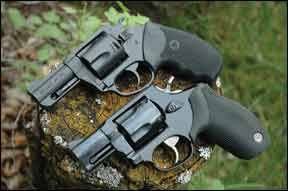
Both are five-shot conventional revolvers, with both SA and DA modes. Both guns had excellent DA and SA pulls, which was something of a surprise to our test crew. Each gun had rubber grips and external hammers and shrouded ejector rods. The frame on the Charter was blackened stainless, while that on the Taurus was aluminum. The guns were very similar in weight and balance, except that the Taurus grip was much larger. In light of our recent experiments with firelapping, we measured the guns inside and out and found some surprises and mistakes that were borne out on the targets.
Because it was difficult to obtain factory-loaded 44 Special ammo, we tested with three handloads and three factory loads, one of which showed up on the UPS truck just as we were concluding our chronographing. The handloads were five grains of Bullseye behind a 250-grain Mt. Baldy (www.MTBaldyBullets.com) cast Keith bullet, the same powder behind a 240-grain Speer JHP, 7.5 grains of Unique behind the Keith bullet, Black Hills cowboy loads with a 210-grain cast RNFP bullet, Remington 246-grain lead RN, and the late-comer, Speer 200-grain Gold Dot Hollow Points. Heres what we found.
Charter Arms Bulldog Model 14420
44 Special, $414
This is the latest version of the popular Charter Bulldog. It was evenly finished in matte black, with black-rubber finger-groove grips that fit our hands well. We thought the overall workmanship was very good, with no visible problems anywhere. There were some little touches that we appreciated, like the beveled front edge of the cylinder and the rounded chin of the barrel shroud, and also the angled-rearward front edge of the front sight, all of which make holstering easier and less damaging to a holster – or your pocket if thats how you carry it. Another touch was the beveled crown that makes the hole in the front of the barrel look that much bigger.
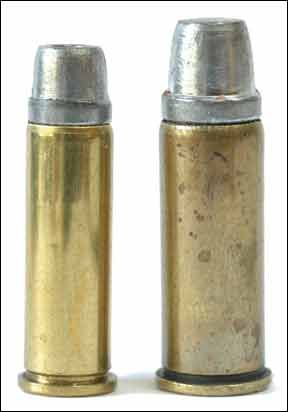
The gun felt a touch on the just-finished side in that all the movements were slightly scratchy, waiting for a little use to smooth them up. We anointed the gun (both guns, actually) with some NanoLube with its tiny round diamonds and worked this in until the gun was smoother. This will happen naturally with normal wear, but we wanted to speed the process. We noted the lockup was dead tight with the hammer and trigger in the firing positions. This beat the Taurus badly, as we found out later.
The Charter website claims there are three lockup points, with an arrow pointing to the front end of the ejector rod. But there is no lock there, just the security of the shroud. (The first iteration of the Bulldog didnt have a shroud.) However, the lockup was mighty tight with the back of the cylinder secured by the axis pin slipping into a hole in the frame, and the ejector sleeve slipping into a notch in the crane just below the rear of the barrel.
We thought the sight picture was excellent. The front sight is a serrated steel ramp, integral with the steel barrel, and its devoid of any red or gold inserts. The rear sight was cut into the frame and was wide and deep enough to give good, fast sighting, far superior to what was on the Taurus. The recessed rear of the rear sight caused it to be in the shadow in most light, which greatly increased the clarity of the sight picture. Those wanting a red front sight can resort to the old standard of nail polish, or if skilled, cut a notch and solder in a brass insert.
The chambers were well polished, but the button-rifled barrel appeared to be quite rough. This gun appeared to be a grand candidate for firelapping, we thought, especially after we saw how our cast-bullet handloads leaded the barrel. That led us to do some measuring. We found the barrel diameter to be 0.4305 inch, with a tight spot at the rifling. The cylinder throats were 0.453, suitably larger than the groove diameter. After most of our accuracy testing we did some modest firelapping, 50 rounds using both NECO and Beartooth products, and succeeded in reducing the tightness at the threads and giving the barrel a great shine that made lead removal much easier. Rechecking most of the ammo previously tried indicated distinct grouping improvement in all cases. For example, the reported average with our 240-grain JHP handload is 3.2 inches. Post-lap groups averaged 2.1 inches. With the Black Hills cowboy loads, average groups went from 2.4 to 2.0 inches. With Speers Gold Dot load, they dropped from 3.3 to 2.5 inches. Our reward for our firelap efforts was so good we decided well continue the process at a later date to remove all traces of tightness at the thread area.
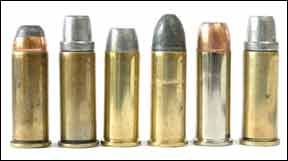
The trigger pulls were very good, we thought. The DA pull was smooth and took about 12 pounds. The SA pull was a delight at 3.8 pounds clean. We repaired to the range and began with our jacketed-bullet handload, to maybe slick up the bore a bit. To our consternation, each succeeding group was worse than the last, beginning at 2.5 inches and getting larger from there. We dont know why this happened, but it went away after the fire lapping process. We switched to our light Keith-bullet load, and our first group was 1 inch for five shots. But the somewhat rough barrel leaded, and the groups got worse. Next was the Black Hills cowboy load, which averaged 2.4 inches, though it struck 4 inches low and 2 inches left. We shot the Speer Gold Dot load, and it struck 5 inches low and gave groups of around 3 inches. Finally, we tried the soft-lead Remington roundnose load of 246 grains, and to our wonder, they went into 1.8 inches. Another group stunned us by making a one-hole cluster that measured 0.7 for five shots, this from a barrel we had not cleaned other than to shoot some jacketed bullets. We would have bet the soft-lead RN bullets would have caked the bore, but it was completely clean. Clearly the Charter will shoot with loads that suit it.
The big disappointment was that all these loads developed only 620 to 675 fps, the latter for the Speer Gold Dot hollowpoints. We doubt even the huge cavity of the 200-grain Gold Dots would open at that speed. We fired the Speer Gold Dot load through a 4-inch barrel and got only 695 fps. In desperation we developed our own personal carry load, which uses 7.5 grains of Unique with the 250-grain cast Keith bullet – which does not need to expand – and it came out of the Bulldog at a whopping 870 fps. This load gave us 3-inch groups on average. We fired that load after all the other testing and after our modest firelapping. Slight leading was still there, but we were not too concerned because this batch of bullets was on the soft side. However, leading or not, for self defense we prefer this load over any of the others tried. Be advised, this load is not for those shooters unaccustomed to significant recoil. All the other test loads gave only modest recoil, we thought. We dont like to use handloads for self defense, but in lieu of anything better wed choose our handload over any of the other loads tested. Buffalo Bore makes an interesting cast wadcutter load for self defense, and it might be another good full-power option to carry in the Bulldog.
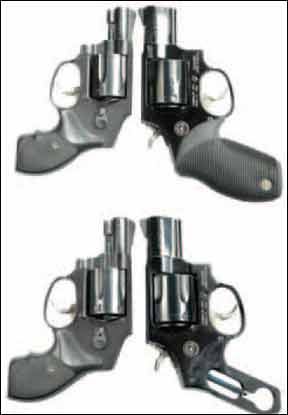
The kicker, so to speak, was the Bulldogs narrow rubber grip tended to twist in our hand from recoil of our heavy handload. The cure will be to get a set of Pachmayr Compac grips, which are fatter but smaller, and we suspect they will be best for this gun. Another good grip replacement would be to get a set of the original wood grips, commonly found on eBay. These do nothing to cut recoil, but do give the gun its smallest and slickest size for better concealment in the pocket. By the way, the trigger guard and grip frame are an aluminum alloy. There is not much need for the strength of steel in those places, and the light metal helps keep the guns weight to just 19.6 ounces empty. Shooting our heavy handload made the twisting gun jam our trigger finger into the sharp inner edge of the trigger guard, so we took a file to it, and now it needs a touch of black paint.
Our Team Said: We like the Charter a lot. With our heavy handload it vastly outshines any and all 38 Special or 357 Magnum loads for self-defense use, in our opinion. We dont recommend shooting heavy loads in this gun all the time, because good practice can be obtained and the gun will surely last longer with lighter target loads. The full load can be reserved for serious carry purposes and will thus do the gun the least long-term damage. With a change of grips and more barrel polishing, this Bulldog will become the backup gun for one of our staff.
Much as we liked it, little things nagged at us. There was nothing at all serious, just cosmetic. We found some spots devoid of finish on the recoil shield, and the ejector rod began to unscrew after 20 shots. So did that of the Taurus. The slight initial operating roughness would have put a few people off, but we thought it was acceptable. The barrel was not the finest inside, but then, this is not designed as a target pistol. We would have liked a slicker barrel, but that would run the cost up.
Taurus Ultra-Lite Model 445B2UL
44 Special, $508
The gun looked great. The slick-looking, gloss-black Taurus had a set of the so-called Ribber grips, which on other guns have cut felt recoil significantly. We thought theyd work well on this little gat, which weighed 21.1 ounces, just 1.5 ounces more than the Charter. However, they were pretty big, making the gun hard to pocket. The Taurus frame was marginally larger than that of the Charter, but was made of aluminum instead of steel. The Taurus, like the Charter, had a steel barrel with integral front sight and ejector-rod shroud, and a steel cylinder. The case-hardened hammer and trigger were both wide, with checkering on the hammer and a smooth face to the trigger.
The cylinder latch was a bit easier to operate than Charters, and was smoothed to avoid cutting the shooting-hand thumb in recoil. The barrel inside looked just beautiful at first glance. Later we found some scratches at the back that caught most of the leading we experienced. The barrel slugged 0.4305 inch, same as the Charter as near as we could measure them. However, the cylinder throats were smaller, at just 0.429 inch. In fact our jacketed and cast reloading bullets would not go through any of the chamber throats except one, which was larger than the others. We knew this was not good, but would wait until we saw target results to make a final determination.
The chambers were nowhere near as highly polished as those on the Charter. Taurus spent time and money on the outside of its cylinder, where Charter spent it on the inside. We wish the inside of the Charters barrel looked like the one on the Taurus. For lockup, the Taurus had a spring-loaded pin at the back of the cylinder, same as the Charter, but a tiny, passive, sprung latch at the crane. We cant imagine this forward latch did much to secure anything. It stuck up a bare 0.040 inch, and went into a thumbnail-shaped cutout in the frame where its slanted outer edge bore against the sharp edge of the cutout when the gun was closed. We later took the rear rod detent out of the cylinder and found the front latch took only a slight push to be overcome. A strong ball detent there, like S&W uses on occasion, would be far better, we thought. The cylinder had lots of play when the hammer and trigger were in the firing positions. This would permit shaving of the bullet, which doesnt help accuracy.
The front sight stuck up nicely, was serrated to cut glare, and looked real good to us. Then we looked through the too-small rear notch and had trouble finding the front-sight blade. There was about no light on either side of the front blade, which gave a very poor sight picture for us. The rear notch was shallow, 0.040 inch. We believe all guns should have decent sights, no matter that in a self-defense situation at very close range the sights wont matter too much. It would be very easy for Taurus to at least widen and maybe deepen the rear notch to give a better sight picture.
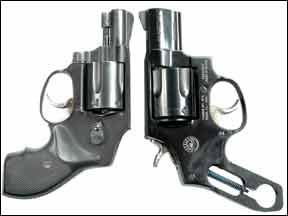
On this gun the barrel, integral front sight, ejector shroud, and cylinder with all its parts, were steel. So were the hammer and trigger. The frame was aluminum, and that helped keep the weight of this Ultra-Lite down. If it had a steel frame, the gun would be way too heavy for its mission. Toward that end, we thought the Ribber grips were way too big also. Under them is a U-shaped frame to which wed have a hard time fitting wood grips, and we could not find any other grips available for this gun. If you have huge grips, you might as well have a bigger gun in front of them. These big rubber grips were mighty hard to fit into a pocket. The gun seemed to be essentially well made. Its trigger pulls were 11.5 pounds DA and 3.4 pounds SA, both smooth and clean.
We took it to the range and to our disgust found the same problem we had had with the Charter, namely our jacketed-bullet handload gave worse groups with each try. Because these jacketed bullets would not go freely through the cylinder throats, we were not too surprised this time, yet we cannot tell you why each group was worse than the last, with either gun. With the Taurus, when we switched to our Keith-bullet handload the groups got progressively better, but not better than 1.8 inches, smallest for the Taurus with that ammo. With Black Hills cowboy loads, the impact was again 4 inches low and 2 left, with 3-inch groups on average. Many of our groups had four pretty close with a flyer, which we suspect was the result of the improperly sized throats. Our later post-reaming tests confirmed this, in fact. With Remingtons lead RN there were no miracles like we had with the Bulldog, with average groups of just over 3 inches. The barrel was, like that of the Charter, clean after these shots with the soft-lead bullets. The Speer Gold Dot factory ammo came floating out at all of 670 fps into average groups of 3 inches. Although the Taurus had a barrel half an inch shorter than that of the Charter, the muzzle velocities were only a touch slower. We suspect part of that was due to the extra chamber pressure generated by the tight throats. Once we reamed the cylinder, our hottest handload with the Taurus was significantly slower, 30 fps, out of the Taurus.
We had one more load to try, our heavy handload. We also had one trick to try on this handgun. We ordered a reamer from our friends at KBC Tools (www.KBCTools.com) to open its throats to 0.432 inch, just right for its 0.4305 grooves. After reaming the gun, we tried it with all previously tried ammo, and with our heavy handload. With the throats now enlarged and entirely uniform, the gun gave us no improvement except for the Black Hills cowboy load, which previously had averaged 3 inches. Our post-reaming groups averaged 2.1 inches. We noted most of the unexplained fliers were now gone too. Our heavy handload averaged 3 inches, and yes, the big grips on the Taurus were far more comfortable than those on the Charter, especially with that load. However, we didnt much like the big grips on the Taurus.
Our Team Said: We loved the look of the inside of the five-groove barrel on the Taurus, except for some bad scratches just in front of the forcing cone that were magnets for lead. We thought the overall workmanship was very good, and we thought the polishing and bluing were excellent. We hated the Tauruss sights, and would probably use a file to open the rear notch if we owned this gun. The relatively loose cylinder lockup was traced to what seems to be excessive width in the cut for the cylinder bolt, or a too-narrow bolt, which could be wiggled easily side to side in its slot. That did nothing for accuracy. Finally, we believe Taurus needs to ream these cylinder throats at the factory to the correct size for the bore, at least 0.431 or possibly 0.432 inch. We think Taurus can and should do better.
0712-SNUBBY-ACC-CHRONO-DATA.pdf
0712-TAURUS-UTLTRA-LIGHT-MODEL.pdf
















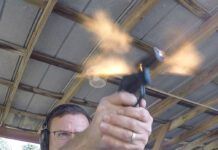
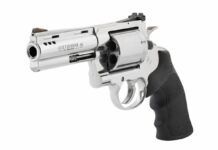

I’m glad you liked the charter. The two I owned were absolute junk. The first one was broke out of the box. The second I fired some Georgia arms ammo through and the cylinder locked up. Broke so bad they gave me a new one. Which I sold. I wouldn’t bank my life on a charter.